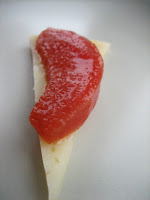 There are many many different types of tacos in Mexico and this is one of them, beef tacos. The key to these tacos is to use chuck-cut of beef, because it is marbled with tissues and fat which melt during the braising (about 2 hours) and give the meat its strong beef-flavour. The meat is amazingly soft and juicy as well.
There are many many different types of tacos in Mexico and this is one of them, beef tacos. The key to these tacos is to use chuck-cut of beef, because it is marbled with tissues and fat which melt during the braising (about 2 hours) and give the meat its strong beef-flavour. The meat is amazingly soft and juicy as well.
And the salsa is as important as the meat (if not more). With meat tacos usually smooth red or green salsas are served. There are many different types of both, but in general red one is made with red tomatoes and dried red chillies, and green one is made with tomatillo and green chillies.
As it is hard to find tomatillos in Europe I stick to the red salsa. Any kind of dried/smoked red chillies can be used but if you do not have substitute with a bit of smoked paprika.
In Mexico corn tortillas for tacos are small, about 10 cm in diameter, so usually two tortillas are served. And tortillas have to be warm, they are never eaten cold, even when they are made of wheat.
Beef tacos
serves 2
400 gr beef (chuck cut)
some oil
salt and pepper
250 gr tomatoes (the more ripe the better, I sometimes use cherry tomatoes)
2 jalapeños
1 onion
2 small garlic cloves, unpeeled
2 guajillo chillies (ancho, chipotle or a pinch of smoked paprika works fine as well)
16 warm corn tortillas (10 cm in diameter)
onion
fresh coriander
lime
Heat some oil in a saucepan, cut the meat in large cubes, salt and pepper and brown in batches. Put back all the meat in the sauce pan and pour in so much water that it covers the bottom, it should not cover the meat. Put the lid on and braise for about 2 hours. Add water from time to time but just so much that it covers the bottom. When done it looks like this:

In the meantime make the salsa. Half the tomatoes (quarter if big), quarter the onions, clean the jalapeño and together with garlic cloves (unpeeled) roast in the oven, 180 C, for about 40 minutes. When done let cool.
Clean dried chillies and soak in hot water until soft (30 minutes). When roasted vegetables are done, squeeze out the garlic, add the soaked chillies and blend everything until smooth. Salt and pepper, add some water if the salsa is too thick.
Chop the onion and coriander. Cut the meat in small cubes. To serve, put some some meat in the middle of a warm tortilla, top with onion, coriander, salsa and a squeeze of lime. Fold in half, open side up and eat!

















































